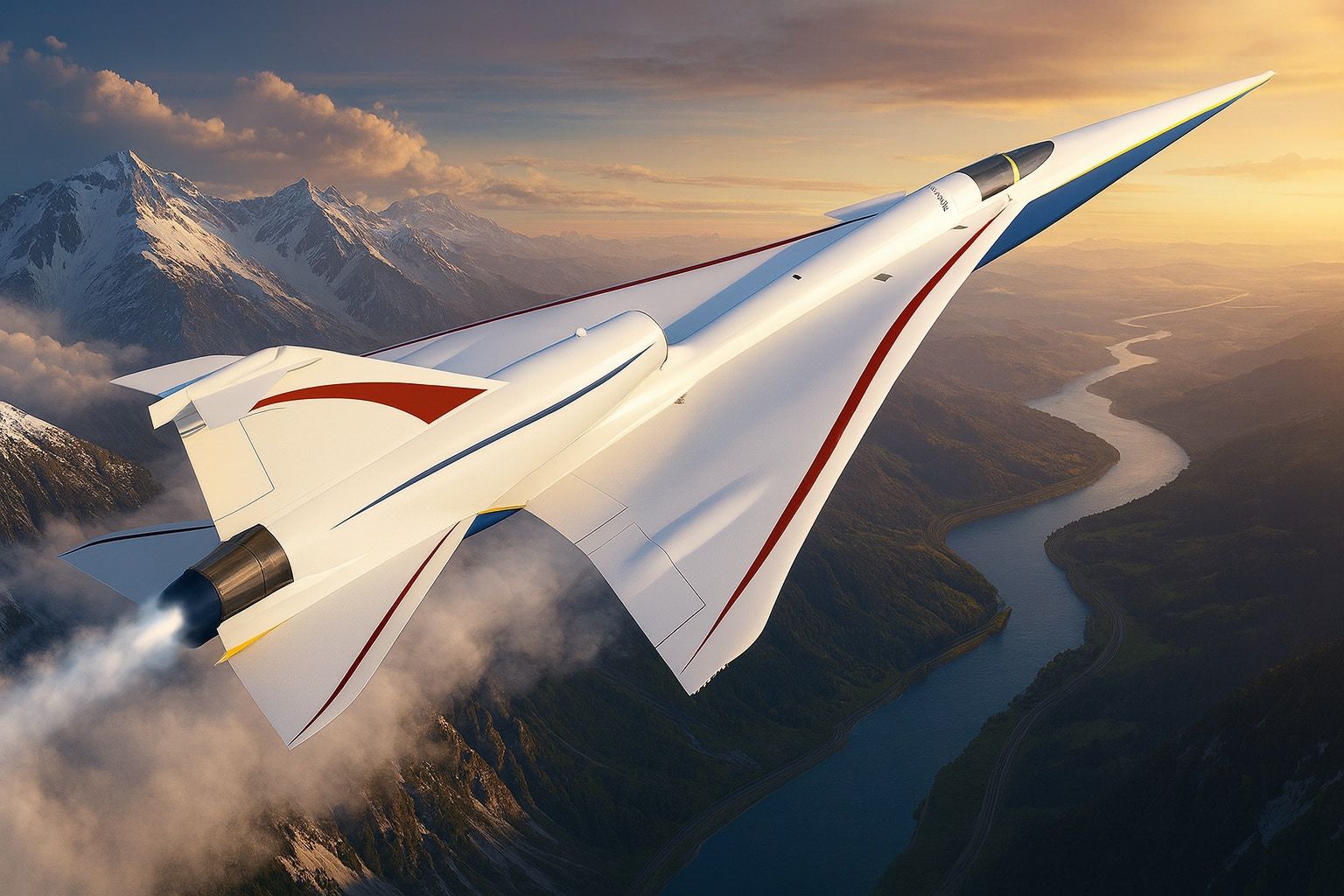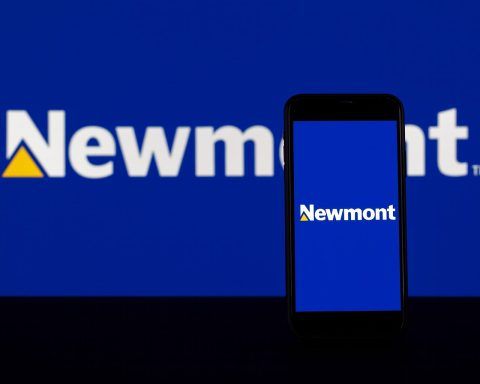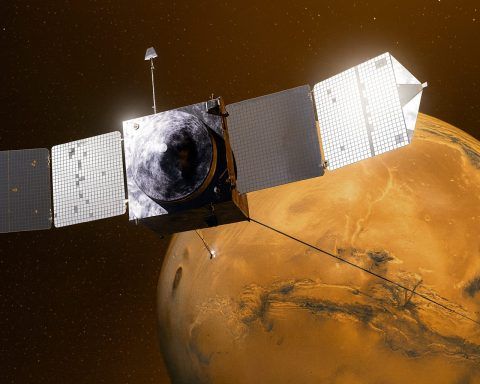- Supersonic debut: NASA’s experimental X-59 QueSST airplane, built with Lockheed Martin, completed its maiden flight in California on Oct. 28, 2025, demonstrating “quiet” supersonic technology [1].
- Sonic boom softened: The sleek jet’s needle-shaped design is engineered to reduce the usual sonic boom to a muted “sonic thump” – reportedly no louder than a car door closing [2] – aiming to enable supersonic flights over land without disruptive noise.
- Milestone moment: Officials hailed the flight as a breakthrough for faster air travel. “This work…has the potential to change the way the public flies,” said Acting NASA Administrator Sean Duffy, calling X-59 a symbol of American ingenuity [3]. Lockheed Martin also lauded the achievement as a testament to its team’s innovation [4].
- Path to faster flights: U.S. regulators plan to use data from X-59 to craft new noise-based rules lifting the ban on civilian supersonic travel over land [5]. If quiet supersonic jets become viable, long flight times could be cut nearly in half – a 6-hour trip might drop to ~3 hours [6].
- Market impact: Lockheed Martin (NYSE: LMT) is the X-59’s prime contractor and has invested years in the project. The company’s stock traded around $487 this week [7], and analysts expect steady growth as cutting-edge programs like the X-59 bolster its tech leadership [8].
A Historic First Flight
After years of development and delays, the X-59 QueSST (Quiet Supersonic Technology) research aircraft finally took to the skies and “successfully completed its first flight” on Tuesday morning, Oct. 28 [9] [10]. The test took place at Lockheed Martin’s Skunk Works facility in Palmdale, California, with NASA test pilot Nils Larson at the controls [11]. The single-seat X-59 took off just after sunrise and landed safely about an hour later at NASA’s Armstrong Flight Research Center, following a planned route toward Edwards Air Force Base accompanied by a chase plane [12] [13]. About 200 aerospace workers and their families lined a nearby highway to watch the sleek jet’s maiden takeoff [14], underscoring the excitement around this milestone.
Lockheed Martin – which has been developing X-59 under a NASA contract worth over $518 million since 2018 [15] – celebrated the event. “We are thrilled to achieve the first flight of the X-59,” said OJ Sanchez, vice president and general manager of Lockheed’s Skunk Works division. “This aircraft is a testament to the innovation and expertise of our joint team, and we are proud to be at the forefront of quiet supersonic technology development.” [16] His words highlight the significance of the feat for the engineers and scientists who spent years designing this unique plane. NASA officials likewise emphasized the flight’s importance. Acting NASA Administrator Sean Duffy (who also serves as U.S. Transportation Secretary) said the X-59 “sustains America’s place as the leader in aviation and has the potential to change the way the public flies” [17]. In other words, this experimental jet’s success is being seen as more than just a one-off test flight – it’s a step toward a new era of high-speed air travel for everyone.
Notably, the first flight was kept intentionally modest in speed and altitude. The X-59 stayed below the sound barrier on this initial outing, reaching about 230 mph (370 km/h) and a peak altitude of 12,000 feet – well under its intended cruising performance [18]. This cautious approach was expected for a maiden flight, focused on basic handling and safety checks. In press materials, NASA had outlined that the first sortie would be a low-speed loop to verify systems integration and airworthiness [19]. With that accomplished, the stage is set to push the envelope in subsequent flights.
Turning the Sonic Boom into a “Thump”
What makes the X-59 truly revolutionary is its promise of supersonic flight without the deafening boom. Traditionally, when an aircraft exceeds Mach 1 (the speed of sound ~761 mph at sea level), it generates shockwaves that merge into two powerful sonic booms – the explosive cracks often heard when fighter jets or the Concorde flew supersonic. These sonic booms can rattle buildings and were a major reason why Concorde was banned from flying supersonic over land, limiting it to transoceanic routes. The X-59 aims to solve this with its radical design: a long, needle-like nose and carefully sculpted airframe that prevent shockwaves from coalescing. Instead of a double boom, the plane produces a softened “sonic thump” – so quiet that people on the ground might hardly notice it [20]. Lockheed Martin likens the sound to the bang of a car door being slammed [21], a world of difference from the window-rattling thunderclap of past supersonic jets.
This low-boom technology is the linchpin for resurrecting passenger supersonic travel. “The X-59 is a one-of-a-kind supersonic aircraft designed to demonstrate the ability to fly at supersonic speeds while reducing the sonic boom to a gentle thump,” Lockheed explains [22]. By proving that a “quiet” sonic profile is achievable, the X-59 directly tackles one of the primary obstacles that grounded supersonic airliners: noise. If the sonic boom problem is solved, regulators could allow supersonic flights over land for the first time in decades, opening the door to airliners that cut travel times dramatically.
Technically, the X-59 is built to cruise at about Mach 1.4 (925 mph or 1,490 km/h) at 55,000 feet altitude [23] – roughly twice the speed and more than twice the cruising altitude of a typical passenger jet. Its stretched fuselage (nearly 100 feet long) and uniquely shaped wings and hull are all optimized to spread out pressure waves. One quirky feature of this design is that the pilot has no forward windshield; the nose is so elongated that a traditional cockpit window would only show the view of the aircraft’s nose. Instead, the X-59 uses an External Vision System – a set of cameras and displays that give the pilot a virtual view ahead [24] [25]. This high-tech workaround allows the jet to maintain its streamlined shape for low sonic signature, without compromising safety. It’s an example of the extreme engineering employed to make quiet supersonic flight possible.
Early tests suggest the concept works. NASA and its partners conducted extensive wind tunnel experiments, including tests on scale models of the X-59 in facilities in the U.S. and Japan, to validate the low-boom design. Those trials indicated that the X-59’s shape will indeed prevent shockwaves from merging into a loud boom [26] [27]. Now, with the real aircraft airborne, the upcoming flights will measure the sound produced in practice. If the “gentle thump” holds true in live tests, it could prove that breaking the sound barrier need not be an ear-splitting affair.
Toward Supersonic Travel for All
The broader goal of the X-59 program – part of NASA’s Quesst mission (Quiet Supersonic Technology) – is to bring supersonic travel back into mainstream aviation, this time without the drawbacks that doomed it before. It has been over half a century since the Concorde first flew passengers at supersonic speeds in 1976 [28]. Concorde’s legend looms large: it could dash across the Atlantic in about 3.5 hours, but its sonic booms, high operating costs, limited range, and a tragic 2000 crash all contributed to its retirement in 2003 [29]. Since then, no supersonic airliner has flown. One of the biggest hurdles has been that regulatory bans (especially in the U.S.) prohibit breaking the sound barrier over land due to the noise. This means any future supersonic transport would be severely limited in where it could fly at full speed – unless those rules change.
That’s where the X-59 comes in. Data from the X-59’s flights will be shared with regulators to help set new noise-based standards for sonic flight [30]. In fact, in June 2025 the White House issued an executive order directing the FAA to develop updated regulations that would allow civil supersonic flights over land, provided they meet specified low-noise criteria [31]. Currently, the U.S. and many countries maintain blanket bans on non-military supersonic flight over land. NASA’s mission is to give policymakers the evidence needed to replace those bans with science-driven noise limits. “The X-59’s successful development and flight testing will inform the establishment of new data-driven acceptable noise thresholds related to supersonic commercial flight over land,” Lockheed Martin noted in its release [32]. In simpler terms, if X-59 proves you can fly faster than sound without bothering people below, authorities may finally green-light a new generation of supersonic passenger planes.
The potential benefits are huge. If future airliners could cruise at Mach 1.4 quietly, travel times could be cut nearly in half. As California’s Governor Gavin Newsom’s office put it while celebrating the X-59, this technology “could unlock a new global market for aircraft manufacturers and enable passengers to travel anywhere in the world in half the time it takes today” [33]. A coast-to-coast flight in the U.S. that now takes 5 to 6 hours could shrink to roughly 2.5–3 hours [34]. Imagine breakfast in New York and lunch in Los Angeles, or flying from London to Sydney overnight instead of a full day. NASA’s quiet supersonic demo is directly aimed at making such scenarios feasible in the future.
Importantly, the industry is watching closely. Several aerospace companies have been eyeing a revival of commercial supersonic travel, and a favorable regulatory environment would be a game-changer for them. Startups like Boom Supersonic and Spike Aerospace have been developing designs for supersonic airliners and business jets, hoping to serve a market for ultra-fast travel [35]. Boom Supersonic, for example, is working on an airliner concept called “Overture” and has garnered interest from airlines – but its viability may hinge on noise regulations and technology proven by efforts like NASA’s X-59. If the ban on supersonic-over-land is lifted for quiet designs, these companies could move forward more confidently, potentially bringing supersonic flight to commercial routes in the 2030s. In that sense, the X-59’s little sonic “thump” in the California desert could resonate across the aviation world.
Government and public support also play a role. The X-59 has already turned heads outside the engineering community – literally in California, where it was just voted the “Coolest Thing Made in California” for 2025 as part of a manufacturing contest [36]. That symbolic honor, bestowed by the state’s tech industry association, highlights how projects like this capture the imagination as harbingers of innovation. “It’s shaping the future of aviation,” Governor Newsom said of the low-boom jet, praising it as a product of California’s creativity and manufacturing excellence [37] [38]. Such public enthusiasm, coupled with policy momentum, creates a favorable climate for supersonic technology to progress from experimental to everyday.
Market Impact: Lockheed Martin’s Bet on Speed
The X-59 program is not just an aerospace experiment; it’s also a strategic investment for Lockheed Martin, one of the world’s largest defense and aerospace companies. Lockheed’s famed Skunk Works unit (builder of legendary aircraft from the U-2 spy plane to the SR-71 Blackbird) led the X-59’s design and construction for NASA. While NASA is funding the project, Lockheed’s involvement means the company is developing valuable expertise in quiet-supersonic flight – know-how that could translate into future contracts or products. It also demonstrates Lockheed’s capacity to deliver on cutting-edge R&D programs, something investors keep an eye on.
So far, Wall Street’s reaction to the X-59’s milestone has been one of general optimism folded into Lockheed Martin’s robust performance. The company’s stock (NYSE: LMT) was trading around $486–$487 per share in late October 2025 [39], not far from its 52-week highs. Earlier in the month, LMT shares briefly topped $500, marking a ~23% jump from their lows earlier in the year [40]. This rise has been driven largely by Lockheed’s strong defense business – the company has a record $166.5 billion backlog of orders as of mid-2025, roughly two and a half years’ worth of revenue in its pipeline [41]. With stable defense budgets and big-ticket programs (like new F-35 fighter contracts, missile systems, and space systems), analysts have forecast about 5% revenue growth for Lockheed in 2025 and ~4% in 2026 [42]. In short, the firm’s core business is healthy.
Where does the X-59 fit into this financial picture? While the X-59 itself is an experimental craft and not a revenue-generating product, its success bolsters Lockheed’s reputation for innovation – which can have long-term business benefits. Demonstrating leadership in advanced technology (be it stealth, hypersonics, or in this case quiet supersonics) helps Lockheed win future contracts and partnerships. It also reassures investors that the company is not just resting on legacy programs but is actively pushing boundaries. “Overall, market observers see Lockheed as on track to fulfill its commitments while investing in future tech like the X-59,” notes an analysis in TS2 Tech [43]. The X-59’s progress is “a positive signal: it underscores Skunk Works’ innovation and adds momentum to a larger portfolio of programs,” that report explains [44].
Veteran aerospace analysts agree the achievement is significant. Guy Norris, a long-time Aviation Week editor and industry expert, predicted that the X-59’s first flight would “mark an aerospace milestone demonstrating Lockheed’s continued innovation in cutting-edge flight technology.” [45] Now that the flight is in the books, Lockheed can indeed tout this milestone. There’s also potential future business: if regulations change and airlines pursue quiet supersonic jets, Lockheed Martin could be a contender to build them (possibly in partnership with commercial plane-makers). Even before that, technology spun off from the X-59 – in materials, aerodynamics, or avionics like the X-59’s camera-based vision system – could find uses in other military or civil aircraft. In sum, the success of X-59 reinforces the perception that Lockheed is positioned to capitalize on next-generation aerospace opportunities, which supports its strong market outlook [46].
Next Steps and Outlook
With the inaugural flight complete, the X-59 program now enters a critical flight-test phase. Over the coming months, NASA and Lockheed will gradually expand the aircraft’s performance envelope – flying higher, faster, and approaching and eventually exceeding the speed of sound [47] [48]. Each test will gauge not only the plane’s handling but also its acoustic signature. Engineers have instrumented the X-59 extensively (recording over 20,000 parameters of data even on early flights) [49], and they will be paying special attention to how loud the sonic thump is on the ground as the jet approaches Mach 1.4. If all goes well, 2026 should see the X-59 regularly cruising at supersonic speeds aloft and verifying that it can do so quietly.
A major goal in this phase is to conduct “community response” tests – flying the X-59 over select communities to see how the public reacts to the low sonic thump. NASA plans to perform a series of these test flights across the United States, gathering data by surveying residents on what they heard (or didn’t hear) when X-59 passed overhead. All that information, along with precise acoustic measurements, will then be presented to regulators like the FAA in the U.S. and the International Civil Aviation Organization (ICAO) globally [50]. The hope is that by demonstrating a viable noise level, NASA can convince authorities to adopt new rules permitting quiet supersonic flight. “The aircraft represents the centerpiece of NASA’s mission to gather information intended to help enable a new era of commercial faster-than-sound air travel over land,” explained Mark Walsh, a senior NASA technologist, underscoring how pivotal X-59 is to the agency’s vision [51].
Several milestones are on the horizon. After refining the X-59’s performance and acoustics in California, the first supersonic test flights – where the jet will finally break the sound barrier – are expected to take place. Lockheed Martin has indicated that achieving the optimal speed and altitude for a “quiet boom” is a key objective of the next test phase [52]. Once the team is confident in the aircraft’s low-boom performance, NASA aims to begin the community overflight experiments (potentially by late 2026, barring any schedule slips). By 2027, the agency could be compiling the data needed to formally propose noise-based rule changes. If regulators are satisfied, we may see the decades-old ban on civil supersonic flight over land finally updated.
Looking further ahead, the implications are exciting. If the X-59 proves successful, it paves the way for new supersonic planes – from business jets to airliners – that can travel at roughly double the speed of today’s jets without a sonic boom shockwave. Aerospace companies around the world would have a green light to pursue designs that were previously untenable under old noise restrictions. It’s conceivable that by the 2030s, a new generation of supersonic business jets could begin service, offering ultra-fast point-to-point travel for those who need it. Larger supersonic passenger airliners might follow, aimed at transoceanic routes first and eventually some overland routes where allowed. All of this, of course, depends on the promise of “quiet supersonic” proving out in practice. The X-59 is the trailblazer in that regard, showing regulators and industry what’s possible.
As we stand now, the successful first flight of the X-59 has injected fresh momentum into supersonic aviation. It’s a moment that combines cutting-edge engineering with policy progress. Skeptics note that there is still a long journey before passengers can routinely fly faster than sound – certification, infrastructure, economic viability, and environmental considerations (like emissions) all have to be addressed. But the hurdle that X-59 addresses – the sonic boom – was arguably the toughest of all. “If the data from this week’s flight and future tests confirm the X-59’s quiet-boom promise, we may soon see development of new business jets and airliners that zip across continents at twice today’s speeds – and do so without the classic sonic boom,” one tech journal observes [53]. In short, the age of quiet supersonic travel, long a dream since Concorde’s retirement, is suddenly on the horizon. The next few years of testing will determine just how quickly that dream can take flight.
Sources: Reuters [54] [55] [56]; Lockheed Martin [57] [58]; TS2 Tech [59] [60] [61] [62]; NASA/California Governor’s Office [63] [64], among others.
References
1. www.reuters.com, 2. www.reuters.com, 3. www.reuters.com, 4. news.lockheedmartin.com, 5. ts2.tech, 6. ts2.tech, 7. ts2.tech, 8. ts2.tech, 9. news.lockheedmartin.com, 10. www.reuters.com, 11. www.reuters.com, 12. www.reuters.com, 13. www.reuters.com, 14. www.reuters.com, 15. www.reuters.com, 16. news.lockheedmartin.com, 17. www.reuters.com, 18. www.reuters.com, 19. www.reuters.com, 20. www.reuters.com, 21. www.reuters.com, 22. news.lockheedmartin.com, 23. www.reuters.com, 24. ts2.tech, 25. ts2.tech, 26. ts2.tech, 27. ts2.tech, 28. www.reuters.com, 29. www.reuters.com, 30. www.reuters.com, 31. ts2.tech, 32. news.lockheedmartin.com, 33. ts2.tech, 34. ts2.tech, 35. ts2.tech, 36. www.reuters.com, 37. ts2.tech, 38. ts2.tech, 39. ts2.tech, 40. ts2.tech, 41. ts2.tech, 42. ts2.tech, 43. ts2.tech, 44. ts2.tech, 45. ts2.tech, 46. ts2.tech, 47. www.reuters.com, 48. ts2.tech, 49. ts2.tech, 50. ts2.tech, 51. ts2.tech, 52. news.lockheedmartin.com, 53. ts2.tech, 54. www.reuters.com, 55. www.reuters.com, 56. www.reuters.com, 57. news.lockheedmartin.com, 58. news.lockheedmartin.com, 59. ts2.tech, 60. ts2.tech, 61. ts2.tech, 62. ts2.tech, 63. ts2.tech, 64. ts2.tech










